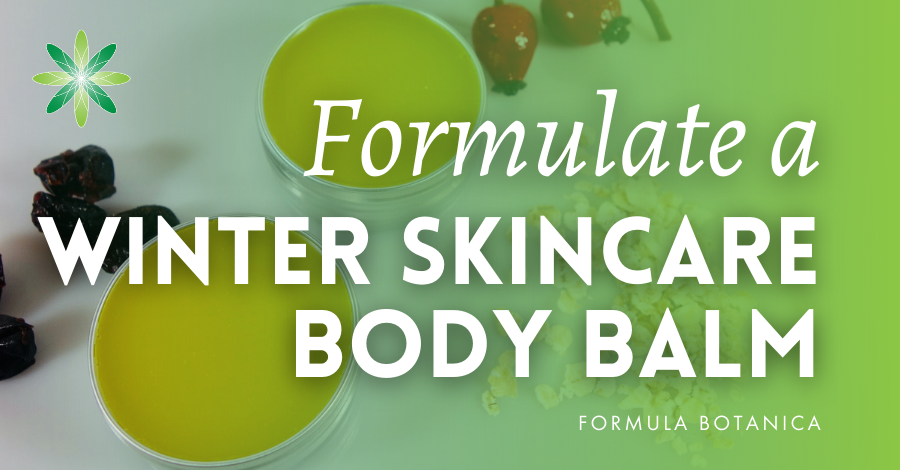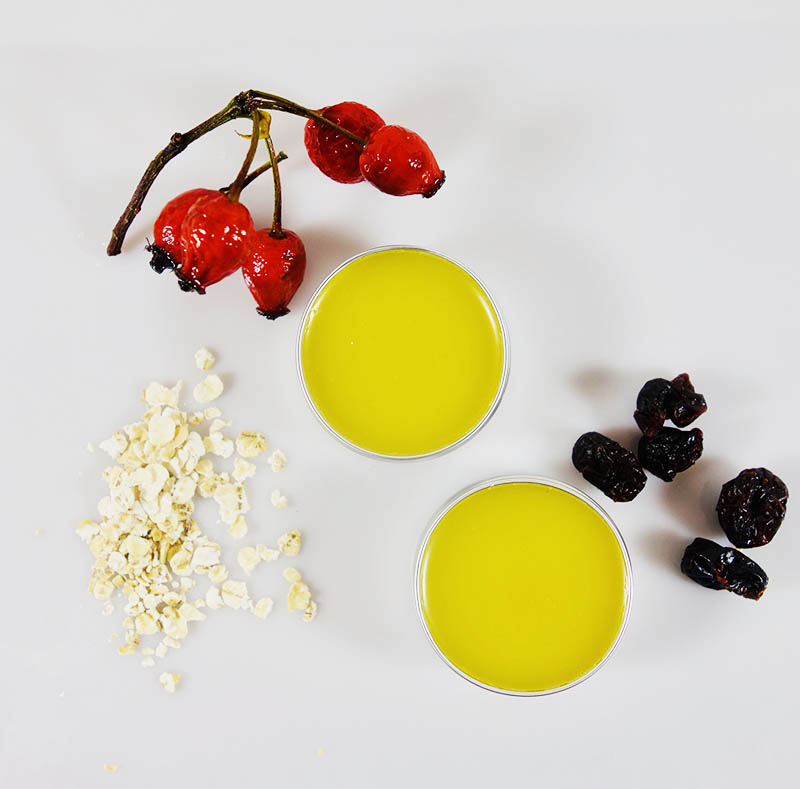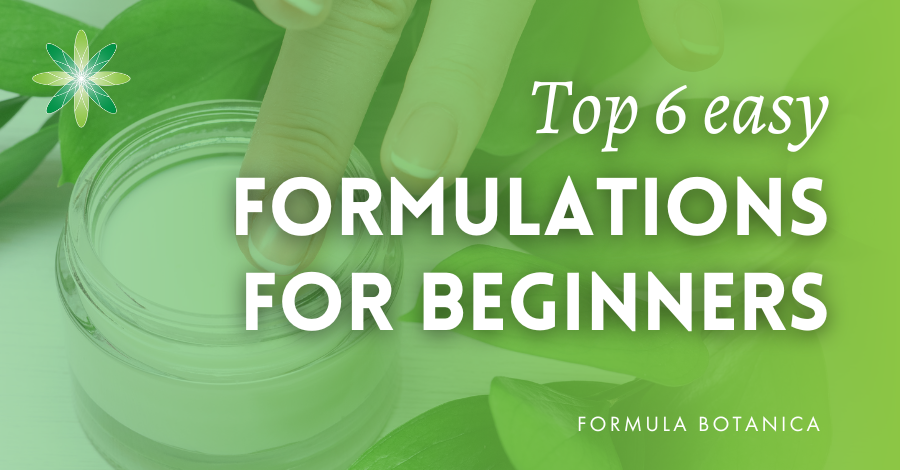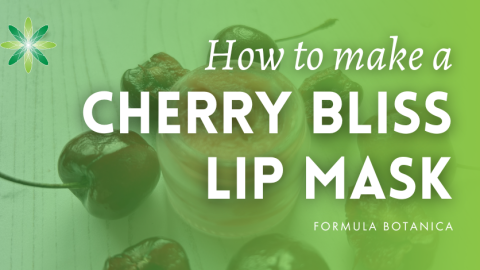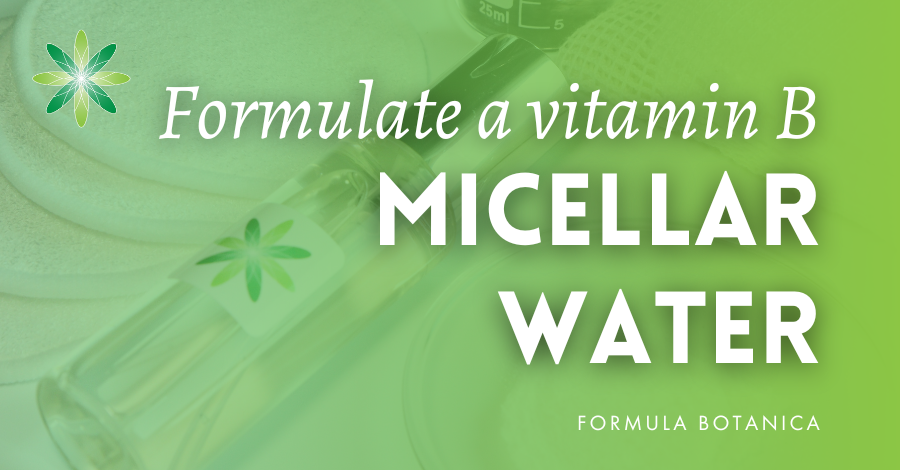New skincare formulators often start out blending oils and butters to experience making their first practical cosmetic products such as lip or body balms. Keeping it simple when taking your first steps into natural formulation makes sense. With anhydrous, or waterless formulations, you generally do not need to worry about adding preservatives.
The oat and cranberry balm formulation we offer in this post is one such easy-to-formulate product and also has the benefit of being particularly useful if it is winter where you are.
We know it is not the season for winter skincare for everyone in the Formula Botanica community as we span the globe. But, the Formula Botanica headquarters are in the UK and it most certainly is winter as we post this formulation for a nourishing and protective body balm. The product gives an occlusive and moisturising film to help prevent trans-epidermal water loss (TEWL) and to safeguard the skin from drying environments whatever the season.
This protective body balm also makes a nice homemade skincare gift for family and friends and is a suitable size to keep in your pocket or handbag to use whenever your skin feels dry; on your cheeks, elbows, chapped lips – you name it.
To make it suitable for children as well as sensitive skin, the formulation avoids using essential oils. In addition, we have created a vegan lifestyle-compatible balm using a plant-based alternative to beeswax that is traditionally used to impart hardness to balms.
Our body balm ingredient choices
Oat oil
This is one of the heroes in this formula and has calming, soothing properties. It is a yellowish colour and has a high proportions of oleic, linoleic and palmitic acids. It is rich in phytosterols, antioxidants and carotenoids, and it helps to restore the skin barrier function. It is also an excellent choice for sensitive or itchy, inflamed skin.
Cranberry seed oil
This is a non-greasy oil, rich in nutrients such as carotenes as well as vitamin E compounds (tocopherols and tocotrienols) that are active against free radical damage. It also contains phytosterols and phospholipids which can soothe itchy, scaly and irritated skin conditions. Similar to oat oil, it is considered to have anti-inflammatory properties and to relieve itching and redness.
Shea and cocoa butters
As emollients, butters are staple ingredients in balms as they help soften the skin. Cocoa butter is best suited to dry skin, but not recommended for very oily skin. Shea butter feels drier than cocoa butter. Using just one is possible, but that would leave a choice between sacrificing the amazing chocolate scent of the cocoa butter or omitting the shea butter resulting in a product that feels too greasy.
If you would like to replace either or both of these butters, research variations and trial combinations with options such kokum, shea nilotica, cupuacu, illipe or kpangnan butters.
Plant-based waxes
Waxes give firmness to balms and help them stay solid in warmer temperatures. Candelilla wax has a distinctive occlusive effect. It is a great protective ingredient for balms and nourishing creams. Carnauba is the most stable wax with a melting point between 80-86°C. It is hydrophobic and gives firmness to the product.
Calendula flower macerated in sunflower oil
Calendula flower does not need an introduction. It is a herb whose anti-inflammatory and soothing properties are well documented. Sunflower oil, which is commonly used for macerating herbs, is easily available, inexpensive and can be used on dry and even irritated skin. Some sunflower oils may have a high content of linoleic acid which gives the oil anti-inflammatory properties; check your supplier’s documentation to find out. It is also a rich source of lecithin.
Avocado oil
This is one of the most nourishing oils and supports the health of the stratum corneum. Rich in unsaponifiable compounds, it is a very protective, emollient oil.
Vitamin E – tocopherol
This is an antioxidant used in the formula because oat, cranberry and avocado oils are prone to oxidise.
Make this @FormulaBotanica easy oat and cranberry body balm to keep your skin nourished and protected all winter long. Great to gift too. #balm #naturalskincare #homemadeskincare Share on X
Our formulation: Oat and Cranberry Body Balm
Makes: 100 grams
Time taken: 30 minutes
Level: a beginner-level formulation that can be personalised and adapted.
| Phase | Ingredients | INCI | Weight (g) |
| A | Unscented shea butter | Butyrospermum Parkii (shea) butter | 20.00 |
| A | Unrefined cocoa butter | Theobroma cacao (cocoa) seed butter | 10.00 |
| A | Candelilla wax | Euphorbia cerifera (candelilla) wax | 6.00 |
| A | Carnauba wax | Copernicia cerifera wax | 3.00 |
| B | Calendula macerate in sunflower oil | Helianthus annuus (sunflower)seed oil and Calendula officinalis flower extract | 20.00 |
| B | Avocado oil | Persea gratissima (avocado) oil | 12.00 |
| B | Peach aromatic extract | Parfum | 0.50 |
| B | Almond cherry aromatic extract | Parfum | 0.50 |
| C | Oat kernel oil | Avena sativa kernel (oat) oil | 17.00 |
| C | Cranberry seed oil | Vaccinium macrocarpon (cranberry) seed oil | 10.00 |
| C | Vitamin E | Tocopherol | 0.5 |
| C | Rosehip CO2 | Rosa canina (rosehip) seed extract | 0.50 |
| Total: 100.00 |
Suggested equipment
- Digital scales
- Stainless-steel bain-marie or a glass beaker
- Water bath or heating bowl
- Glass rods
- Aluminium tin or tube for packaging
- Infrared or other suitable thermometer
Method of Manufacture
- Preparation
Sterilise your utensils and working space and wear appropriate lab PPE according GMP.
- Weighing
Weigh your ingredients in phase A and put them into the beaker. Place them in a hot bath or bain-marie on a hot plate or another heat source.
- Phase B
When the waxes and butters are melted, remove the beaker from the heat source, stir and slowly add the oils in phase B and the aromatic extracts. These are extracts in alcohol and therefore not as heat-sensitive as essential oils. They need some heat to blend in the mixture well.
- Cooling phase
When the blend cools below 50°C, add the oat oil and once below 40°C, add the cranberry oil which is the most heat sensitive. Finally, add the tocopherol and rosehip CO2 extract.
- Setting and decanting
The body balm will soon start to solidify, so now pour it into your chosen containers – either aluminium tins or tubes.
- Final cool-down phase
Leave them to cool down completely before putting on lids.
Body balm formulating tips
- You can replace the oils if desired. Use what you have in stock already. Consider the heat sensitivity of some carrier oils.
- The aromatic extracts and unrefined cocoa butter used together in our body balm formulation create a scent like that of chocolate pralines. The aromatic extracts’ INCI is parfum, but they are food-grade extracts in alcohol and are 100 percent natural origin. Feel free to experiment with scents to suit you. Always check the INCI and if need be, ask your supplier for further information on scents listed as parfum.
- This combination and amount of waxes and butters helped achieve the desired balance of texture and hardness. If using fewer waxes, replacing carnauba wax with a plant-based lanolin results in a much softer texture and one more suitable for a squeeze tube. Using a bit more carnauba wax resulted in a harder product that will be more difficult to get out of the tin and apply, especially in cold weather.
- It also makes a difference if you use refined vs. cold-pressed oil. Feel free to experiment.
- In one of our experiments, we tried adding oat kernel flour, which is a fine powder. This removes a bit of the greasy feel, but if not stirred in well, it can result in the balm having tiny specks and as these are unevenly distributed the final texture of the balm will not seem as smooth.
Suggested Suppliers
Peach aromatic extract – Aromazone (EU)
Cherry almond aromatic extract – Aromazone (EU)
Oat Oil – Aromantic (UK), Alexmo Cosmetics (EU) or Manske (EU)
Cranberry seed oil – Soap Kitchen (UK/EU), Elemental (EU) and Lotioncrafter (USA)
FAQs
What is the difference between a body balm and body butter?
A natural body balm is a waterless formulation, also called an anhydrous formulation, made of a combination of natural, botanical oils, butters and waxes. A balm is usually a firm-set product which melts on application to the skin. A body butter, while also made of oils and butters, is a softer cosmetic product and can also be whipped to include air and give a lighter, fluffier feel. The difference lies in the choice of butters and oils. A body balm would use more butters like cocoa butter which are harder at room temperature and include some waxes to give firmness. A body butter is not likely to include any waxes.
What do you use a body balm for?
Body balms are ideal products to give a moisturising boost to dry skin and to provide an occlusive layer on the skin to prevent trans-epidermal water loss and the skin’s dehydration. Depending on its formulation, a balm can be used externally on just about all areas of the skin, such as dry patches on elbows and feet and also chapped lips.
How do you make a balm?
Body balms are easy skincare products to make at home. As anhydrous formulations they have the advantage of generally not needing preservatives. They are made by simply melting the desired formulation comprising butters and waxes over a heat source such as a bain marie or water bath. Then, remove from the heat source and blend in the oils. Pour into cosmetic jars before leaving to cool completely and adding the lids. The skill of balm making is to melt the ingredients with the highest melting points first before adding more heat-sensitive oils. Essential oils must be added in the cool down phase below 40°C. Graininess can occur if the formulation is heated or cooled too fast or not thoroughly blended.
Where can I learn to formulate natural skincare and haircare?
Join us at Formula Botanica, where tens of thousands of students and followers take our free and paid online courses to learn how to formulate organic skincare and haircare for themselves or to sell and also how to set up a beauty brand and business.
FREE TRAINING
Learn how to become an
Organic Skincare Formulator
FREE TRAINING
How to become an
Organic Skincare Entrepreneur
FREE TRAINING
How to become an
Organic Skincare Entrepreneur
Leave us a comment
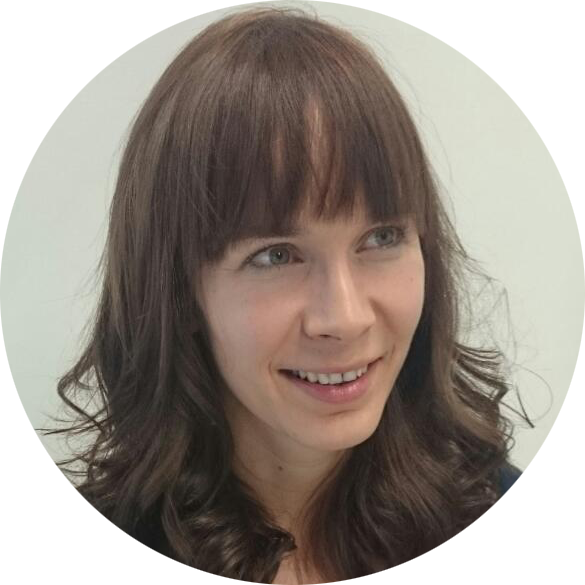
Barbora Harmatova is a Formulator as well as a Tutor at Formula Botanica, where she helps our students to become better organic cosmetic formulators. Read more about the Formula Botanica Team.

